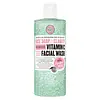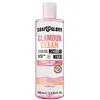What's inside
What's inside
 Key Ingredients
Key Ingredients

 Benefits
Benefits

 Concerns
Concerns

 Ingredients Side-by-side
Ingredients Side-by-side

Water
Skin ConditioningSodium Lauroyl Methyl Isethionate
CleansingGlycerin
HumectantAcrylates Copolymer
PEG-7 Glyceryl Cocoate
EmulsifyingCocamidopropyl Betaine
CleansingCoco-Glucoside
CleansingGlyceryl Oleate
EmollientLauric Acid
CleansingSodium Methyl Isethionate
EmulsifyingSynthetic Wax
AbrasiveDipropylene Glycol
HumectantParfum
MaskingSodium Hydroxide
BufferingSodium Chloride
MaskingTetrasodium EDTA
Zinc Laurate
Limonene
PerfumingAscorbyl Glucoside
AntioxidantPolyquaternium-7
Benzophenone-4
UV AbsorberAmyl Cinnamal
PerfumingButylphenyl Methylpropional
PerfumingCitric Acid
BufferingLinalool
PerfumingMagnesium Nitrate
Citral
PerfumingCitrus Junos Fruit Extract
Skin ConditioningAlpha-Isomethyl Ionone
PerfumingLecithin
EmollientAscorbyl Palmitate
AntioxidantMethylchloroisothiazolinone
PreservativeMagnesium Chloride
Tocopherol
AntioxidantHydrogenated Palm Glycerides Citrate
EmollientMethylisothiazolinone
PreservativeMaltodextrin
AbsorbentCI 73360
Cosmetic ColorantCI 77891
Cosmetic ColorantCI 42090
Cosmetic ColorantWater, Sodium Lauroyl Methyl Isethionate, Glycerin, Acrylates Copolymer, PEG-7 Glyceryl Cocoate, Cocamidopropyl Betaine, Coco-Glucoside, Glyceryl Oleate, Lauric Acid, Sodium Methyl Isethionate, Synthetic Wax, Dipropylene Glycol, Parfum, Sodium Hydroxide, Sodium Chloride, Tetrasodium EDTA, Zinc Laurate, Limonene, Ascorbyl Glucoside, Polyquaternium-7, Benzophenone-4, Amyl Cinnamal, Butylphenyl Methylpropional, Citric Acid, Linalool, Magnesium Nitrate, Citral, Citrus Junos Fruit Extract, Alpha-Isomethyl Ionone, Lecithin, Ascorbyl Palmitate, Methylchloroisothiazolinone, Magnesium Chloride, Tocopherol, Hydrogenated Palm Glycerides Citrate, Methylisothiazolinone, Maltodextrin, CI 73360, CI 77891, CI 42090
Water
Skin ConditioningButylene Glycol
HumectantPolysorbate 20
EmulsifyingCapryl/Capramidopropyl Betaine
CleansingPentylene Glycol
Skin ConditioningSodium Chloride
MaskingDisodium EDTA
Propylene Glycol
HumectantCetrimonium Bromide
AntimicrobialGlycerin
HumectantCucumis Sativus Juice
EmollientCucumis Sativus Fruit Extract
EmollientLycium Barbarum Fruit Extract
AstringentPrunus Persica Fruit Extract
AbrasiveAloe Barbadensis Leaf Juice Powder
Skin ConditioningCentaurea Cyanus Flower Extract
AstringentSodium Hydroxide
BufferingBenzyl Alcohol
PerfumingPhosphoric Acid
BufferingSodium Benzoate
MaskingPotassium Sorbate
PreservativeSodium Sulfite
PreservativeCitric Acid
BufferingAscorbic Acid
AntioxidantWater, Butylene Glycol, Polysorbate 20, Capryl/Capramidopropyl Betaine, Pentylene Glycol, Sodium Chloride, Disodium EDTA, Propylene Glycol, Cetrimonium Bromide, Glycerin, Cucumis Sativus Juice, Cucumis Sativus Fruit Extract, Lycium Barbarum Fruit Extract, Prunus Persica Fruit Extract, Aloe Barbadensis Leaf Juice Powder, Centaurea Cyanus Flower Extract, Sodium Hydroxide, Benzyl Alcohol, Phosphoric Acid, Sodium Benzoate, Potassium Sorbate, Sodium Sulfite, Citric Acid, Ascorbic Acid
 Reviews
Reviews

Ingredients Explained
These ingredients are found in both products.
Ingredients higher up in an ingredient list are typically present in a larger amount.
Citric Acid is an alpha hydroxy acid (AHA) naturally found in citrus fruits like oranges, lemons, and limes.
Like other AHAs, citric acid can exfoliate skin by breaking down the bonds that hold dead skin cells together. This helps reveal smoother and brighter skin underneath.
However, this exfoliating effect only happens at high concentrations (20%) which can be hard to find in cosmetic products.
Due to this, citric acid is usually included in small amounts as a pH adjuster. This helps keep products slightly more acidic and compatible with skin's natural pH.
In skincare formulas, citric acid can:
While it can provide some skin benefits, research shows lactic acid and glycolic acid are generally more effective and less irritating exfoliants.
Most citric acid used in skincare today is made by fermenting sugars (usually from molasses). This synthetic version is identical to the natural citrus form but easier to stabilize and use in formulations.
Read more about some other popular AHA's here:
Learn more about Citric AcidGlycerin is already naturally found in your skin. It helps moisturize and protect your skin.
A study from 2016 found glycerin to be more effective as a humectant than AHAs and hyaluronic acid.
As a humectant, it helps the skin stay hydrated by pulling moisture to your skin. The low molecular weight of glycerin allows it to pull moisture into the deeper layers of your skin.
Hydrated skin improves your skin barrier; Your skin barrier helps protect against irritants and bacteria.
Glycerin has also been found to have antimicrobial and antiviral properties. Due to these properties, glycerin is often used in wound and burn treatments.
In cosmetics, glycerin is usually derived from plants such as soybean or palm. However, it can also be sourced from animals, such as tallow or animal fat.
This ingredient is organic, colorless, odorless, and non-toxic.
Glycerin is the name for this ingredient in American English. British English uses Glycerol/Glycerine.
Learn more about GlycerinChances are, you eat sodium chloride every day. Sodium Chloride is also known as table salt.
This ingredient has many purposes in skincare: thickener, emulsifier, and exfoliator.
You'll most likely find this ingredient in cleansers where it is used to create a gel-like texture. As an emulsifier, it also prevents ingredients from separating.
There is much debate on whether this ingredient is comedogenic. The short answer - comedogenic ratings don't tell the whole story. Learn more about comegodenic ratings here.
The concensus about this ingredient causing acne seems to be divided. Research is needed to understand if this ingredient does cause acne.
Scrubs may use salt as the primary exfoliating ingredient.
Learn more about Sodium ChlorideSodium Hydroxide is also known as lye or caustic soda. It is used to adjust the pH of products; many ingredients require a specific pH to be effective.
In small amounts, sodium hydroxide is considered safe to use. However, large amounts may cause chemical burns due to its high alkaline.
Your skin has a natural pH and acid mantle. This acid mantle helps prevent harmful bacteria from breaking through. The acid mantle also helps keep your skin hydrated.
"Alkaline" refers to a high pH level. A low pH level would be considered acidic.
Learn more about Sodium HydroxideWater. It's the most common cosmetic ingredient of all. You'll usually see it at the top of ingredient lists, meaning that it makes up the largest part of the product.
So why is it so popular? Water most often acts as a solvent - this means that it helps dissolve other ingredients into the formulation.
You'll also recognize water as that liquid we all need to stay alive. If you see this, drink a glass of water. Stay hydrated!
Learn more about Water